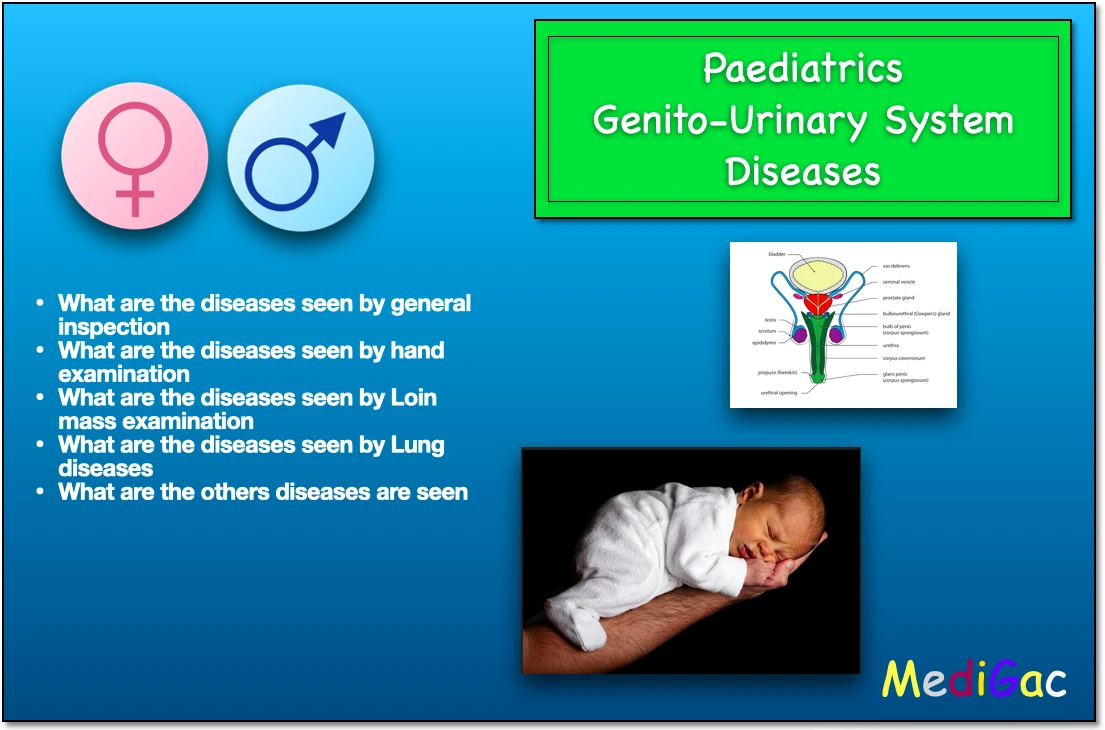
We have discussed the common diseases of genital and urinary system in the newborn child, neonates or children under paediatrics age group.
- What are the diseases seen by general inspection
- What are the diseases seen by hand examination
- What are the diseases seen by Loin mass examination
- What are the diseases seen by Lung diseases
- What are the others diseases are seen
I. What are the diseases we can Inspect :
- The assessor looks for any puffy face or sick appearance caused by CKD.
- Then examines the pallor, which reveals a pale renal facies with a pale, sallow, and somewhat yellow pigmented tone.
- Kussmaul breathing : This refers to acidosis in CKD, AKI, AGN, and RTA (chronic renal disease, acute kidney injury, acute glomerulonephritis, and acute glomerulonephritis) (Renal tubular acidosis)
- A uremic fetor smells like urine and breathes like a fish.
- Hirsurtism was discovered in CNI poisoning.
- Rash is a symptom of vasculitis.
- Gingival hyperplasia: This happens as a result of CNI (Calcineurin inhibitor) toxicity in people with CKD.
II. Hand examination :
- Leuconychia – In hypoalbuminemia, this is an opaque white line.
- Leuconychia striata, or Muehrecke’s nail, is a band-like pale discoloration found in chronic hypoalbuminemia.
- Haemodialysis A-V fistula
- In renal failure, Mee’s line is a single transverse white line.
- Carpal tunnel syndrome is a type of carpal tunnel syndrome.
- CKD patients have half and half nails, with the distal nail brown or red and the proximal nail pink or white.
- Asterixis – Asterixis is a fluttering tremor seen in uremia as well as severe hepatic and respiratory disorders.
- In chronic hypoalbuminaemia, Beu’s line transverse grooves or furrows on the nail plate.
III. Loin mass :
- Gangioneuroma is a type of ganglioneuroma.
- Polycystic kidney disease (PKD) is a condition that affects the kidneys.
- Perinephric abscess is a type of perinephric abscess.
- Hydronephrosis is a condition in which a person’s kidneys are
- Dermoid cyst
- Wilm’s tumour is the third type of tumour.
- Neuroblastoma (neuroblastoma) is a type of neurogenic disorder.
IV. Lung diseases :
- A pleural effusion, similar to nephrotic syndrome, with diminished breath sound and dullness.
- Fine crackles are a symptom of heart failure or left ventricular failure.
- Pleurisy with uremic pleurisy and pleural rub
- Coarse crackles, which occur when pneumonia is present.
- Pneumonia and asthma are two of the most frequent kidney disorders.
- In asthmatic patients, wheezing is a protracted expiration.
V. Other diseases :
- Pruritis – This is a complication of uremia that can result in scratch marks and hyperphosphatemia.
- Uremia frost – This is crystalline urea that appears as a white powder deposition on the skin.
- Keratopathy in the shape of a band – The examiner looks at the end of the cornea, which can be observed medially or laterally. This is limbic calcification in a patient with long-term hyperparathyroidism and high calcium and phosphate levels.
- The tone of the eyeball is examined
- The BCG markings are examined
- If there is brown line colouring, it should be noted.
- Red eye condition is number seven
- Retinal alterations due to hypertension